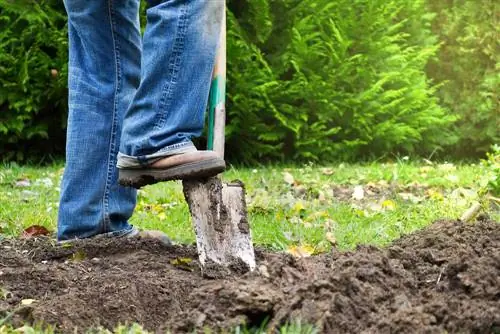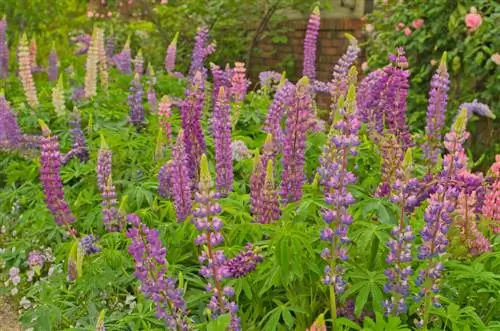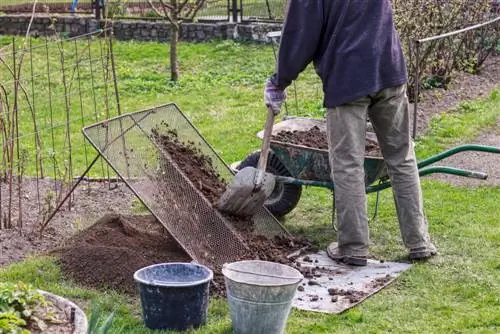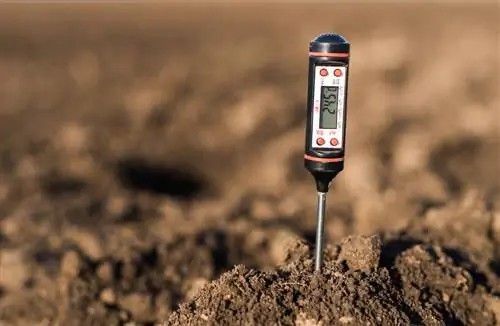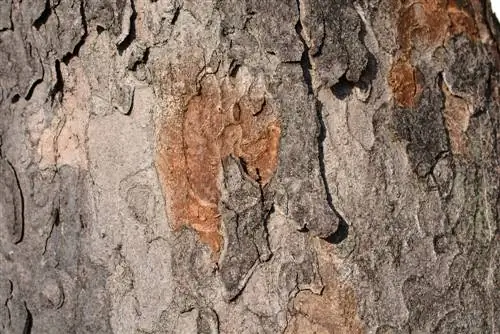- Author admin [email protected].
- Public 2023-12-16 16:46.
- Last modified 2025-06-01 06:02.
If the flowering and productivity of your garden plants leave something to be desired, the quality of the garden soil comes into focus. These instructions explain how you can draw well-founded conclusions about the nature of the soil using simple means. If defects become apparent, they can be quickly remedied with the help of our tips.
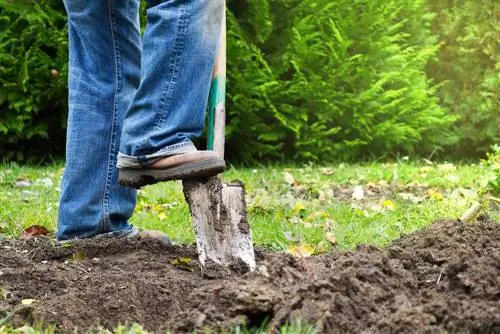
How to improve the quality of garden soil?
To improve the quality of the garden soil, depending on the type of soil, you can incorporate mature compost, horse manure or chicken manure, apply fine-grained sand and lime or sow deep-rooted green manure such as lupins and radish. This promotes a balanced mix of loam, sand, clay and humus for optimal plant growth.
What characterizes impeccable garden soil?
Your flowers, shrubs and vegetable plants want a balanced mixture of loam, sand, clay and humus. If these components are in a he althy relationship with one another, there is active soil life made up of microorganisms as a basic requirement for vital growth, flowering and productivity. The following properties characterize the ideal garden soil:
- A crumbly, loose and yet structurally stable consistency
- Rich in nutrients and trace elements
- Deep and with reliable water drainage
- Moderately dry, fresh or fresh-moist, without risk of waterlogging
- Ideal pH value between 5.5 and 7.5
Few home gardeners enjoy the privilege of immaculate garden soil. However, that is no reason to forgo having your own ornamental, vegetable and herb garden. By adding simple additives, you can compensate for any defects that occur.
Determine soil quality with a hand test - this is how it works
The actual crumb structure of the soil determines which additives you use to improve the garden soil. You can reliably determine the type of soil with a hand test. To do this, form a handful of soil into a roll between your palms. You can distinguish between the different types of soil based on the following properties of the soil sample:
- Sandy soil: mostly grainy and too crumbly to form a ball
- Clay soil: can be squeezed into a smooth ball and roll, does not stick to the palms
- Clay soil: forms a sticky, smooth roll with a shiny surface when rubbed
Only in exceptional cases are you dealing with pure sand, loam or clay soil. As a rule, it is a mixture of all three components. You can use the hand sample to determine which component dominates or is too abundant in your garden soil. From this you can draw conclusions about the right measures to optimize the structure so that it comes close to the ideal conditions.
Soil found to be too light - what to do now
Only a few survivors from the plant kingdom, such as cacti and succulents, thrive in pure sandy soil. If it still contains small amounts of humus, this soil quality is only suitable for a rock or heather garden. If the hand test indicates that the structure is too sandy and light, use the following measures to give the soil more stability so that water and nutrients are stored better. How to do it right:
- In the fall, incorporate 3 to 5 liters of mature compost per square meter into the dug soil
- Alternatively mix in composted horse manure or chicken manure
- Then sow a hardy green manure
- Mow the biomass in spring and rake it into the soil
Test PH value
To determine the pH value in the garden soil, garden centers and hardware stores offer test sets (€14.00 on Amazon) that do not require any prior chemical knowledge. If the result indicates a value below 5.5, this is regulated using algae lime or garden lime. As a rule of thumb: 10 grams of lime per liter of soil increases the value by one point.
Optimize heavy soil - this is how it works
In loamy and clayey soil that is too heavy, plants are constantly threatened by waterlogging and lack of oxygen. Furthermore, the earth stays cold for a long time in spring, so your perennials have difficulty growing. Special soil additives that loosen and aerate the soil provide relief. How to improve soil quality:
- Dig the ground two spades deep before the onset of winter
- Incorporate mature compost into the soil at a dosage of 3 liters per square meter
- Sprinkle fine-grained sand on the surface and spread it evenly with the rake
This combination of different additives eliminates current compaction and effectively prevents this problem. You round off the package of measures with deep-rooted green manure. Lupins, oil radishes and other deep-rooted plants also loosen the soil so that waterlogging and lack of air are a thing of the past.
Tip
Hand sample and pH value test are not enough to determine the quality of the soil if you want to create a garden after building a new building. Instead, take soil samples from 10 to 12 places and send them to a specialized laboratory. The experts there carry out a detailed soil analysis and give well-founded recommendations on planting and fertilizer requirements.

